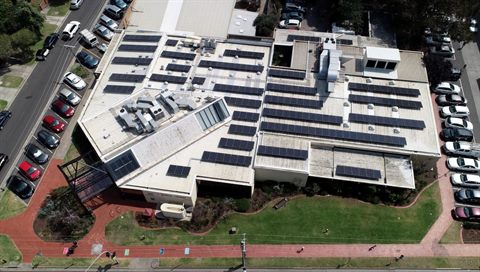Melbourne’s Hobsons Bay City Council is committed to reaching its goal of zero net greenhouse gas emissions by 2030, and it is striving for this ambition through its Large Scale Solar Installation Program. The program, which could see up to 3.6 MW of solar installed and managed through a Virtual Power Plant (VPP) shared among Council-owned assets and even the wider community.
In November 2019, Council launched a public tender process in order to ascertain the best way to roll out its fast-tracked large scale solar installation program. From the expressions of interest provided in this period it became clear to Council that. VPP was the standout path forward.
Thus, Council launched another tender process between May and July 2020 with specifications including a minimum requirement of 1.5 MW new photovoltaic solar generation capacity and VPP capability. Council landed upon a VPP which would enable it to move its generated solar energy from one site that is producing more to another site to maximise emission reduction.
Council expects the VPP, now called the Virtual Energy Network (VEN) to result in:
- capacity of 3,610 kW (including 1,830 kW from the base case and an additional 1,780 kW from expansion sites)
- a total reduction of Council’s direct emissions by an estimated 55 per cent
- a positive net present value project which will fully cover its costs within nine years
- offering Council tenants the option to purchase solar power from the VPP at a discounted rate, with both Council and tenants benefiting from the investment
- the option for Hobsons Bay community members to participate in the VPP, including contributing power into the VPP (and generating revenue), as well as accessing low-cost locally generated green power
Hobsons Bay City Council is also hoping to strengthen VEN through the addition of batteries. Indeed VEN has no limitations on it, and could grow significantly in the future to incorporate community solar energy producers, the inclusion of private renters wishing to participate to lower their bills and emissions, and even another community VPP.
“Because of the inherent flexibility o the system allowing easy entry to and exit from the program,” said Council on its Meeting Agenda, “Council could offer community benefit in numerous ways. This flexibility extends to Council itself in that Council could cease operation of the VPP at any time it chooses and revert to site-by-site solar PV systems.”
“I’m really pleased that we will be able to share the benefits of this project with community groups, sports clubs and other tenants of our buildings,” said Hobsons Bay Mayor Cr Colleen Gates, “not only from a carbon emissions reduction perspective but also in helping them save costs. What is exciting is that residents of Hobsons Bay will also have the opportunity to become part of the VPP.”
Hobsons Bay City Council already has a number of solar installations across its assets, including a 50 kW array on Altona North Community Library, a 55 kW install atop Altona Meadows Library and Learning Centre, and an 86 kW set up on Laverton Community Hub.
VPPs are gaining traction in the public sector of late. Only last week, Western Australia’s Solar Schools Program launched in the Pilbara town of Port Hedland, will see solar installed on 30 regional WA high schools, 10 of which will turn into smart VPPs.
Solar suppliers and contractors have not yet been announced but Council expects work to begin in early 2021 and take up to 18 months, creating 20 direct jobs on its way.
This content is protected by copyright and may not be reused. If you want to cooperate with us and would like to reuse some of our content, please contact: editors@pv-magazine.com.









By submitting this form you agree to pv magazine using your data for the purposes of publishing your comment.
Your personal data will only be disclosed or otherwise transmitted to third parties for the purposes of spam filtering or if this is necessary for technical maintenance of the website. Any other transfer to third parties will not take place unless this is justified on the basis of applicable data protection regulations or if pv magazine is legally obliged to do so.
You may revoke this consent at any time with effect for the future, in which case your personal data will be deleted immediately. Otherwise, your data will be deleted if pv magazine has processed your request or the purpose of data storage is fulfilled.
Further information on data privacy can be found in our Data Protection Policy.